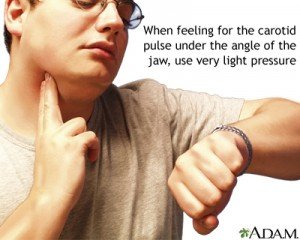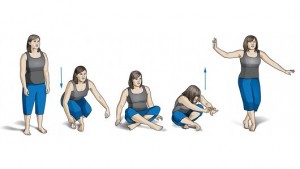Three Easy Ways You Can Predict Your Lifespan In 10 Minutes
Take these three tests that are predictive of lifespan right in your own home all by yourself. If you’re overweight and/or out of shape, do yourself a favor and read this post.
TYPICALLY, IN order to get a handle of on your mortality you need to go to some medical practitioner who will poke, prod and draw some blood.
Your HDL level (the “good” cholesterol), triglycerides, blood pressure, and the granddaddy of them all – telomere length – can do a decent job of predicting lifespan.
A medical person could run tests to measure all this and more. But you can get a pretty good fix on your probable life expectancy right at home all by yourself with three tests.
The three indicators that have some pretty good odds of predicting lifespan are:
- Waist circumference,
- Pulse rate and
- The sitting-rising test.
Let’s dive into each test, with the aim of enabling you to do them. For those of you with unhappy outcomes, there will also be an intervention plan.
#1 Waist circumference
What’s your waist size?
If you have a tape measure it’s easy to figure out, and is worth doing because waist circumference is an indicator of life expectancy.
(If you don’t have a tape measure, simply wind a string around your waist – just below the navel – mark where one end overlaps and then measure this distance along a ruler.)
Your waist measurement should be no more than half the length of your height.
Before we jump into waist circumference as a predictor of lifespan, let’s take a quick look at what it replaced – BMI.
“BMI”, or “body mass index” has been a quickly measured, maybe-accurate indicator of where a person body mass ranks on a scale from lean to obese, and by extension, a person’s lifespan.
BMI is calculated as a person’s weight divided by the square of their height.
BMI, however, is fraught with issues, not only as a predictor of lifespan but as a measurement of fatness, as I describe in Just Exactly How Far Are You Anyway?.
The problem with BMI is that people with more muscle than average will weigh more than their un-muscular brethren, and thereby have a higher BMI number. They will not, however, actually be fat for the simple reason that muscle weighs 40% more than fat.
So, say you and I both are six feet tall and weigh 200 pounds. Our BMI would be 27, which is in the “overweight” category. (The BMI calculator is in this article.) But, if you eat fish and veggies, and weight train four times per week, and I eat Doritos and couch surf, it’s likely that your extra weight will be muscle and mine will be fat.
In this case, our BMI number will accurately predict my fatness, but will overestimate yours. For the very short, the very tall, or the muscular, BMI is as useful to determining healthy weight, as is a bicycle to a fish*
Turns out, waist circumference seems to be a much better way to predict your lifespan than BMI anyway.
The American Cancer Society Study of 100,000 People
The conclusion of the American Cancer Society study of more than 100,000 people over nine years is that…
Irrespective of your weight, your waist size is the key to health.
Having a large waist size doubled the risk of dying from any cause during the nine-year period of the study as compared to those with smaller waits, and this was true whether the person was of normal weight, overweight or obese.
What are the key metrics here?
- For men, a waist size of 47 inches or larger.
- For women, a waist size of 42 inches or larger.
- For anyone, your waist should not exceed half the length of your height.
Now please note that these lofty numbers are not good, but are the limit of girth before havoc ensues.
As measured just below the belly button, a waist size of 47 inches or larger for men and 42 inches or larger for women doubled the risk of dying during the nine year study period, compared to those with smaller waists, which were 35.4 inches for men and 29.5 inches for women.
Keeping your waist circumference to less than half of your height can help prevent the onset of conditions like stroke, heart disease and diabetes and add years to life, researchers said.
Specific to height, and varying little as compared to the above cited averages for all heights, using the “one-half of height rule” means that a man six foot tall, needs a waistline smaller than 36 inches, while a five foot, four inch woman should have a waist size no larger than 32in.
Having a larger waist was associated with a higher risk of death whether the person was normal weight, overweight or obese. Moreover, a large waist size doubled the risk of dying from any cause during the study period compared to those with smaller waists.
And ladies, take note of this:
The association between women’s waist size and mortality risk was strongest among women who were at normal weight. Among normal-weight women, the risk of dying increased about 25 percent for each additional four inches of waist size.
That implies that waist size is at least as important to monitor and control as weight.
The lead researcher in the study, epidemiologist Eric Jacobs said,
“Even if your weight is normal for your height, if your waist size is increasing, if you’re moving to a bigger pant size, that’s a warning sign that it’s time to start eating better and exercising more.” (Source)
A thick waist has long been considered a risk factor for heart disease, but now we know that it also increases risk for dying from cancer, respiratory failure and other causes.
Having a large waist is correlated with large amounts of visceral fat around the abdominal organs, which can cause inflammation, high cholesterol, insulin resistance and other problems linked with poor health.
So, take out that tape measure and get your waist line number… it may just be the extra incentive you need to eat better and start exercising, even if it’s only walking… which I’ll dive into below.
#2 Pulse Rate
What’s your resting pulse rate?
If you have two fingers, it’s easy to figure out, and – as I remarked about waist circumference – is worth doing, as pulse rate is an independent predictor of life expectancy.
Even in healthy people in good physical condition!
This conclusion comes from a Danish study published in Heart where researchers tracked 2,798 participants’ heart rate and oxygen consumption data from 1986 thru 2011.
After controlling for physical fitness and other health and behavioral factors, they found that the higher the resting heart rate, the greater the risk for death.
Compared with men with rates of 50 beats a minute or less, those at 71 to 80 beats had a 51 percent greater risk. At 81 to 90 beats, the rate of death was doubled, and over 90 it was tripled.
People with resting pulses of 80 beats per minute die four to five years earlier than those with pulses of 65 beats per minute.
Does a higher resting heart rate translate to an earlier death even among those who are healthy and exercise regularly?
The researchers found that the answer is “yes”, that resting heart rate is not just a marker of fitness level, but an independent risk factor.
According to previous research by Jensen and his colleagues, people with resting pulses of 80 beats per minute die four to five years earlier than those with pulses of 65 beats per minute.
What’s crazy about that stat is that this is the same difference in life expectancy, in the same individuals, as having a lifetime cancer diagnosis or not.
“If you have two healthy people,” said the lead author of the Danish study, Dr. Magnus Thorsten Jensen, “exactly the same in physical fitness, age, blood pressure and so on, the person with the highest resting heart rate is more likely to have a shorter life span.” (Source)
How to check your pulse?
The easiest way for me to take it is simply to put two fingers against my carotid artery, like this fella demonstrates:
 You can count the pulse beats over 30 seconds and multiply the result by two to get your pulse rate per minute, or just be patient and count during the whole 60 seconds.
You can count the pulse beats over 30 seconds and multiply the result by two to get your pulse rate per minute, or just be patient and count during the whole 60 seconds.
Make sure you’re at rest, meaning that you’ve been sitting or lying down for a while – you want to measure your lowest non-sleeping heart rate.
Once you have the number, you can go to the Life Expectancy Estimator by Hearth Rate site, type in your resting pulse and, magically, predict your lifespan.
This is what mine looks like:
#3 The Sitting-Rising Test
Yeah, sure you can lie on the floor and then stand up, but can you do it without leaning against anything or touching the floor with a hand or elbow?
Like this:
The “sitting-rising test” measures your fitness at the most basic level. It not only tests muscular strength, but also flexibility, balance and motor coordination. All of these attributes are essential for day-to-day living, and for maintaining your independence as you age.
I asked a four of my friends to try this test. All were collegiate athletes once upon a time, and all currently exercise consistently. Only one was able to do it, albeit quite wobbly.
They all had the required strength, but what was missing was mobility and flexibility.
Kelly Starrett’s MobilityWod site has a good definition of mobility:
“[Mobility] is a movement-based integrated full-body approach that addresses all the elements that limit movement and performance including short and tight muscles, soft tissue restriction, joint capsule restriction, motor control problems, joint range of motion dysfunction, and neural dynamic issues. In short, mobilization is a tool to globally address movement and performance problems.” (Source)
If we don’t consistently stretch and do mobility exercises, with age comes tightness and restricted mobility.
Nearly any child can do the sitting-rising test and it’s not because they’re strong.
In his no frills video, “Coy Boy” demonstrates how most of us will perform the sitting-rising test. Notice the difference between how Coy attempts the test with his tight lower back and hip flexors compared to the children:
Need an incentive to learn how to accomplish the sitting-rising test?
Well, a Brazilian Study determined this:
- How well you can sit and rise from the floor, without using assistance from your hands, knees or other body parts, may predict your risk of dying prematurely in the next six years.
- Those who scored the lowest, requiring the most assistance to sit and rise from the floor, were 6.5 times more likely to die during the study period than those who scored the highest.
The study scores a person’s ability to stand up off the floor based on how much assistance they need.
As Coy Boy in the above video referred to, a score of 10 is given to those who can sit down and rise up from the floor without any assistance from some inanimate object, a friend, elbow or hand.
Each time some assistance is needed, the score is reduced.
– Those who scored 0-3 were 6.5 times more likely to die during the study than those who scored 8-10.
– Those who scored 3.5 to 5.5 were 3.8 times more likely to die.
– Those who scored 6 to 7.5 were 1.8 times more likely to die.
Want the details, and don’t mind reading subtexts? Here’s the Brazilian study:
Here’s a faster, simplier presentation, particularly if you’re an English speaker:
Let’s Take A Walk
If you’ve measured both your waist circumference and pulse rate and are now about to make out your Last Will and Testament, take heart and heed this:
Improving both your pulse rate and waist circumference can be accomplished by doing one thing three times a weeks.
According to Dr. Mike Evans, this one intervention will:
- Reduce Knee Arthritis discomfort by 47%
- Reduce the incidence of Alzheimer’s and Dementia by 50%
- Reduce the incidence of Diabetes 58%
- Reduce the incidence of Hip Fractures in postmenopausal women by 48%
- Reduce Depression from between 37 to 47%
- Reduce the risk of Death by 23%
Do yourself a favor of taking a look at Dr. Evans entertaining, informative and useful video, “23 1/2 Hours”:
Some Concluding Thoughts
If you sit all day, have a high pulse rate and your waist is bigger than you are tall… well… isn’t it great that now you know that you need to do something about it.
What to do?
First realize that it took a long time to get where you are, and it will take some time to get someplace else.
Next, work on your Mindset. Nothing will happen if you will not change your attitudes and habits. If you need a leg up on how to form habits, check out these posts:
Humiliation or Rejection – What’s Holding You Back?
How To Change When Change Is Hard
How To Make Tiny Habits Big
Once you get your mind primed to make some lifestyle changes, shape the path. What I mean by this is to make sure that what change you attempt is doable.
If you want to lose some weight and begin walking, for instance, consider beginning this way:
1. Add water. Before every meal, drink so much pure water that you begin to feel full. At this point, don’t worry about eating differently. Just add water. This will cause you to consume fewer calories. Tackle the quality of your food after water drinking becomes habitual.
2. Stop eating two hours before bedtime. If you get hungry, drink tea. If you’re also on a resistance training program (weight lifting), drink a glass of water before bed mixed with branch chain amino acids (“BCAA”). This will feed your muscle during the sleep time fast period. Over time, increase the two hours to three.
3. Start walking. Find the time to do it — morning, noon or night. Find a buddy to accompany you. As you get accustomed to walking, walk up hills. If there are no hills, pause several times during your walk and do squats.
4. Start doing mobility exercises. Challenge yourself by trying to accomplish the sitting-rising test. Check out some of the mobility exercises in the post, Get Strong, Muscular and Mobile (Fast).
You can extend not only the quantity of your years, but also the quality, by making these few simple changes to your lifestyle. Make it so that in a few months when you again do these tests to predict your lifespan, you’ll be cruising to a healthy old age.
Go for it!
Yep.
* This is derived from the joke, “A woman needs a man like a fish needs a bicycle”.
P.S. One last thing… get some inspiration right here:
Last Updated on October 9, 2019 by Joe Garma





